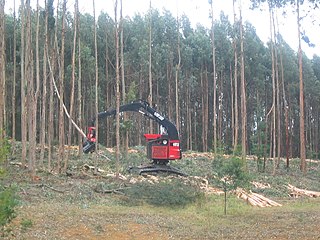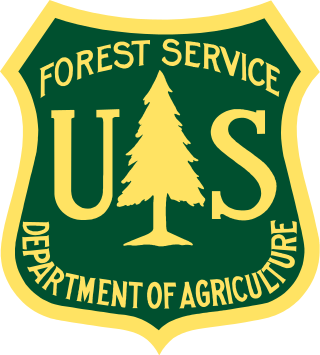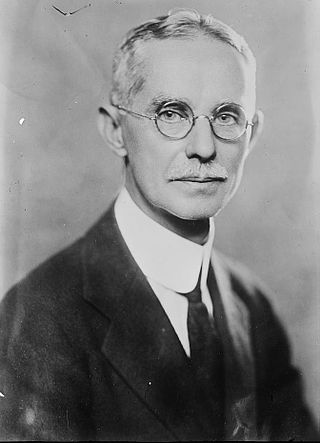
Newsprint is a low-cost, non-archival paper consisting mainly of wood pulp and most commonly used to print newspapers and other publications and advertising material. Invented in 1844 by Charles Fenerty of Nova Scotia, Canada, it usually has an off white cast and distinctive feel. It is designed for use in printing presses that employ a long web of paper, rather than individual sheets of paper.

Pulp is a fibrous lignocellulosic material prepared by chemically, semi-chemically or mechanically producing cellulosic fibers from wood, fiber crops, waste paper, or rags. Mixed with water and other chemicals or plant-based additives, pulp is the major raw material used in papermaking and the industrial production of other paper products.

Paper engineering is a branch of engineering that deals with the usage of physical science and life sciences in conjunction with mathematics as applied to the converting of raw materials into useful paper products and co-products. The field applies various principles in process engineering and unit operations to the manufacture of paper, chemicals, energy and related materials. The following timeline shows some of the key steps in the development of the science of chemical and bioprocess engineering:

Pulpwood can be defined as timber that is ground and processed into a fibrous pulp. It is a versatile natural resource commonly used for paper-making but also made into low-grade wood and used for chips, energy, pellets, and engineered products.

Kenaf [etymology: Persian], Hibiscus cannabinus, is a plant in the family Malvaceae also called Deccan hemp and Java jute. Hibiscus cannabinus is in the genus Hibiscus and is native to Africa, though its exact origin is unknown. The name also applies to the fibre obtained from this plant. Kenaf is one of the allied fibres of jute and shows similar characteristics.

Bagasse is the dry pulpy fibrous material that remains after crushing sugarcane or sorghum stalks to extract their juice. It is used as a biofuel for the production of heat, energy, and electricity, and in the manufacture of pulp and building materials. Agave bagasse is similar, but is the material remnants after extracting blue agave sap.

Georgia Southern University is a public research university in the U.S. state of Georgia. The largest campus is in Statesboro, with additional campuses in Savannah and Hinesville. Founded in 1906, Georgia Southern is the fifth-largest institution in the University System of Georgia. The university offers over 140 different academic majors in the bachelor's, master's, and doctoral levels. The university has a combined enrollment of approximately 27,000 students from all 50 states and over 80 countries. Georgia Southern is classified among "R2: Doctoral Universities – High research activity" and a "comprehensive" university by the University System of Georgia.

The kraft process (also known as kraft pulping or sulfate process) is a process for conversion of wood into wood pulp, which consists of almost pure cellulose fibres, the main component of paper. The kraft process involves treatment of wood chips with a hot mixture of water, sodium hydroxide (NaOH), and sodium sulfide (Na2S), known as white liquor, that breaks the bonds that link lignin, hemicellulose, and cellulose. The technology entails several steps, both mechanical and chemical. It is the dominant method for producing paper. In some situations, the process has been controversial because kraft plants can release odorous products and in some situations produce substantial liquid wastes.

The recycling of paper is the process by which waste paper is turned into new paper products. It has a number of important benefits: It saves waste paper from occupying homes of people and producing methane as it breaks down. Because paper fibre contains carbon, recycling keeps the carbon locked up for longer and out of the atmosphere. Around two-thirds of all paper products in the US are now recovered and recycled, although it does not all become new paper. After repeated processing the fibres become too short for the production of new paper, which is why virgin fibre is frequently added to the pulp recipe.

The Forest Products Laboratory (FPL) is the national research laboratory of the United States Forest Service, which is part of USDA. Since its opening in 1910, the FPL has provided scientific research on wood, wood products and their commercial uses in partnership with academia, industry, tribal, state, local and other government agencies. The laboratory is headquartered in Madison, Wisconsin. The focus of the Forest Products Laboratory is to promote healthy forests and forest-based economies through the efficient, sustainable use of the Nation's wood resources.

The naval stores industry produces and markets products derived from the oleoresin of pine trees, including rosin, tall oil, pine oil, and turpentine. It does this by collecting and processing organic forest products refined from slash pine and longleaf pine trees. The naval stores industry was associated with the maintenance of the wooden ships and sailing tackle of pre-20th century navies, which were caulked and waterproofed using the pitch of the pine tree.

The National Historic Chemical Landmarks program was launched by the American Chemical Society in 1992 to recognize significant achievements in the history of chemistry and related professions. The program celebrates the centrality of chemistry. The designation of such generative achievements in the history of chemistry demonstrates how chemists have benefited society by fulfilling the ACS vision: Improving people's lives through the transforming power of chemistry. The program occasionally designates International Historic Chemical Landmarks to commemorate "chemists and chemistry from around the world that have had a major impact in the United States".

Charles Holmes Herty Sr. was an American academic, scientist, and entrepreneur. Serving in academia as a chemistry professor to begin his career, Herty concurrently promoted collegiate athletics including creating the first varsity football team at the University of Georgia. His academic research gravitated towards applied chemistry where he revolutionized the turpentine industry in the United States. While serving as the president of the American Chemical Society, Herty became a national advocate for the nascent American chemical industry and left academia to preside over the Synthetic Organic Chemical Manufacturers' Association (SOCMA) and the Chemical Foundation. He was also instrumental in the creation of the National Institutes of Health. Towards the end of his career, Herty's research and advocacy led to the creation of a new pulp industry in the Southern United States that utilized southern pine trees to create newsprint.
Bleaching of wood pulp is the chemical processing of wood pulp to lighten its color and whiten the pulp. The primary product of wood pulp is paper, for which whiteness is an important characteristic. These processes and chemistry are also applicable to the bleaching of non-wood pulps, such as those made from bamboo or kenaf.
Tree-free paper, also known as no tree paper, offers an alternative to traditional wood-pulp paper due to its unique raw material composition. This type of paper is considered more eco-friendly especially when evaluating its entire life cycle.

The environmental effects of paper are significant, which has led to changes in industry and behaviour at both business and personal levels. With the use of modern technology such as the printing press and the highly mechanized harvesting of wood, disposable paper became a relatively cheap commodity, which led to a high level of consumption and waste. The rise in global environmental issues such as air and water pollution, climate change, overflowing landfills and clearcutting have all lead to increased government regulations. There is now a trend towards sustainability in the pulp and paper industry as it moves to reduce clear cutting, water use, greenhouse gas emissions, fossil fuel consumption and clean up its influence on local water supplies and air pollution.
Shaanxi University of Science & Technology is a university located in Shaanxi province, China.

Paper chemicals designate a group of chemicals that are used for paper manufacturing, or modify the properties of paper. These chemicals can be used to alter the paper in many ways, including changing its color and brightness, or by increasing its strength and resistance to water. The chemicals can be defined on basis of their usage in the process.
RYAM is an American chemical company specializing in cellulose-based products. Headquartered in Jacksonville, Florida, it produces more than 25 grades of high-purity performance fibers for products ranging from food, cosmetics, and pharmaceuticals to paints, filters, impact-resistant plastics, and digital display screens. In 2014, Rayonier and Rayonier Advanced Materials split into separate companies. Rayonier retained the real estate and forest resource components while RYAM took over management of the performance fibers division.
Mechanical pulping is the process in which wood is separated or defibrated mechanically into pulp for the paper industry.















